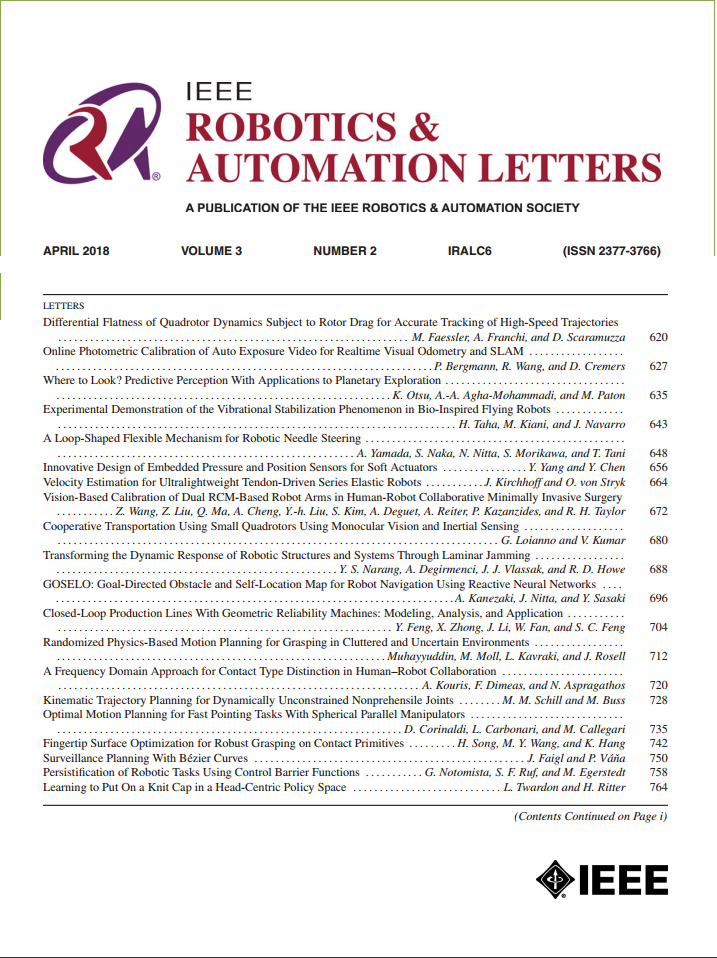Neuromorphic Attitude Estimation and Control
IF 4.6
2区 计算机科学
Q2 ROBOTICS
引用次数: 0
Abstract
The real-world application of small drones is mostly hampered by energy limitations. Neuromorphic computing promises extremely energy-efficient AI for autonomous flight but is still challenging to train and deploy on real robots. To reap the maximal benefits from neuromorphic computing, it is necessary to perform all autonomy functions end-to-end on a single neuromorphic chip, from low-level attitude control to high-level navigation. This research presents the first neuromorphic control system using a spiking neural network (SNN) to effectively map a drone's raw sensory input directly to motor commands. We apply this method to low-level attitude estimation and control for a quadrotor, deploying the SNN on a tiny Crazyflie. We propose a modular SNN, separately training and then merging estimation and control sub-networks. The SNN is trained with imitation learning, using a flight dataset of sensory-motor pairs. Post-training, the network is deployed on the Crazyflie, issuing control commands from sensor inputs at 500 Hz. Furthermore, for the training procedure we augmented training data by flying a controller with additional excitation and time-shifting the target data to enhance the predictive capabilities of the SNN. On the real drone, the perception-to-control SNN tracks attitude commands with an average error of 3.0 degrees, compared to 2.7 degrees for the regular flight stack. We also show the benefits of the proposed learning modifications for reducing the average tracking error and reducing oscillations. Our work shows the feasibility of performing neuromorphic end-to-end control, laying the basis for highly energy-efficient and low-latency neuromorphic autopilots.神经形态姿态估计与控制
小型无人机的实际应用主要受到能源限制的阻碍。神经形态计算为自主飞行提供了极其节能的人工智能,但在真正的机器人上进行训练和部署仍然具有挑战性。为了从神经形态计算中获得最大的好处,有必要在单个神经形态芯片上执行端到端的所有自主功能,从低级姿态控制到高级导航。这项研究提出了第一个使用尖峰神经网络(SNN)有效地将无人机的原始感官输入直接映射到运动命令的神经形态控制系统。我们将该方法应用于四旋翼飞行器的低空姿态估计和控制,将SNN部署在一个微小的crazyfly上。我们提出了一个模块化的SNN,分别训练然后合并估计和控制子网络。SNN通过模仿学习训练,使用感觉-运动对的飞行数据集。训练后,网络部署在crazyfly上,从传感器输入发出500 Hz的控制命令。此外,对于训练过程,我们通过飞行控制器增加额外的激励和对目标数据进行时移来增强训练数据,以增强SNN的预测能力。在真正的无人机上,感知-控制SNN跟踪姿态命令的平均误差为3.0度,而常规飞行堆栈的平均误差为2.7度。我们还展示了所提出的学习修改对于减少平均跟踪误差和减少振荡的好处。我们的工作显示了执行神经形态端到端控制的可行性,为高能效和低延迟神经形态自动驾驶仪奠定了基础。
本文章由计算机程序翻译,如有差异,请以英文原文为准。
求助全文
约1分钟内获得全文
求助全文
来源期刊

IEEE Robotics and Automation Letters
Computer Science-Computer Science Applications
CiteScore
9.60
自引率
15.40%
发文量
1428
期刊介绍:
The scope of this journal is to publish peer-reviewed articles that provide a timely and concise account of innovative research ideas and application results, reporting significant theoretical findings and application case studies in areas of robotics and automation.
 求助内容:
求助内容: 应助结果提醒方式:
应助结果提醒方式:


